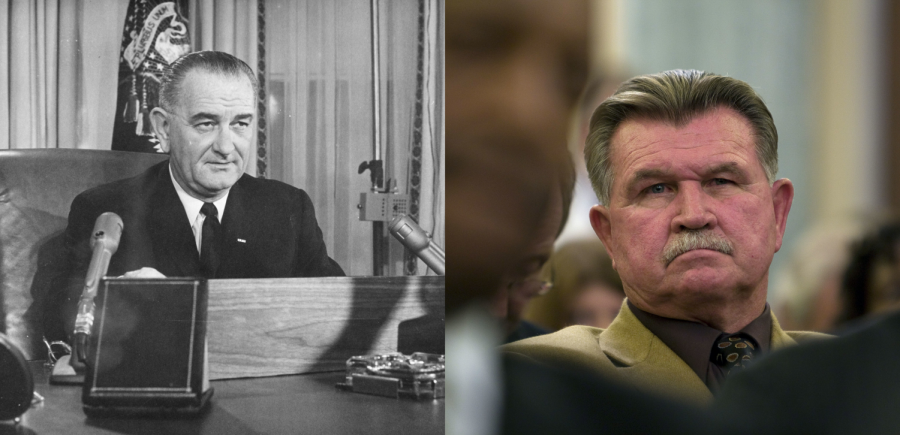Column | A Panther match for U.S. presidents
Left: Lyndon B. Johnson served as the 36th president of the United States. Keystone/Hulton Archive/Getty Images | TNS. Right: Mike Ditka played as tight end for the Pitt Panthers from 1958 to 1960. Chuck Kennedy | MCT, TNS
January 22, 2021
In honor of inauguration week, here’s a list of some of Pitt sports’ most iconic figures, and the president whose career they most resemble.
George Washington: Jock Sutherland, Guard/Football Head Coach
Sutherland, like Washington, began his career in the trenches (albeit as an offensive lineman), playing for Pitt’s football team from 1915 to 1917, before leaving a year early to fight in World War I. He was a stalwart of early Panthers teams and won seven national titles with the program, two as a player and five as the head coach. Washington had cities and towns named after him — Sutherland is even a campus dorm. Sutherland’s sustained success makes him a fitting counterpart for one of the greatest presidents.
James Madison: Matt Canada, Offensive Coordinator
Canada is a football mastermind, the brains behind the 2016 Panthers’ prolific offense. Smarts only count for so much, though — Canada has bounced from team to team throughout his coaching career. Madison, similarly, is lauded as one of the most intelligent presidents, but became unpopular in the White House, courtesy of the War of 1812.
James Monroe: Dave Wannstedt, Head Coach, Football
Wannstedt had ups and downs as Pitt football’s head coach — he led the Panthers to a 13-9 upset of No. 2 West Virginia in the 2007 Backyard Brawl, but also saw his team choke away a 21-point lead against Cincinnati in the 2009 Big East Championship Game. Monroe had successes and failures as well — he signed the Monroe Doctrine, but also dealt with economic collapse during the Panic of 1819.
Teddy Roosevelt: Dan Marino, Quarterback
Marino and Roosevelt have earned reputations as two of the greatest ever in their respective fields — gunslinging icons (be it literal or metaphorical) who changed the face of their profession. In addition, both held celebrity status that went far beyond their day jobs.
Franklin Roosevelt: Heather Lyke, Athletic Director
Since becoming the Panthers’ athletic director in 2017, Lyke has had a hand in the revival of numerous Pitt programs — helping rebuild both the men’s and women’s soccer and basketball programs, for example. Her leadership out of a difficult era for Pitt sports brings to mind FDR’s work in the Great Depression.
Dwight Eisenhower: Jeff Capel, Head Coach, Basketball
Capel became Pitt basketball’s head coach following Kevin Stallings’ disastrous tenure, taking the reins amidst uncertainty and turmoil. He has since revived the program and looks to take it to new heights, much like Eisenhower’s steadfast period of leadership and progress during an intense phase of the Cold War.
John F. Kennedy: Larry Fitzgerald, Wide Receiver
Larry Fitzgerald will go down in history as one of the best wide receivers in college and NFL history. Despite his dominance, his career raises the question of what could have been, just like JFK after his assassination. In college, Fitzgerald received one of the worst Heisman snubs of all time. In the NFL, he never managed to win the Super Bowl, toiling in irrelevance on terrible Cardinals teams.
Lyndon Johnson: Mike Ditka, Tight End/Defensive End
Brash, stubborn and determined to get things done no matter the cost, both Johnson and Ditka gained fame for their hard-hitting leadership and big personalities. Johnson was known for his elaborate pranks — Ditka for his vitriolic style.
Richard Nixon: Kevin Stallings, Head Coach, Basketball
Both Stallings and Nixon had careers based on reducing competition — Nixon worked to end the Vietnam War, while Stallings turned Pitt basketball into a doormat. Stallings found himself embroiled in controversy after leaving Pitt and destroyed part of the taped evidence.
Gerald Ford: Sal Sunseri, Linebacker/Interim Head Coach
Sunseri was head coach for just one game during the 1992 season — like Ford, he achieved office after the ousting of his predecessor and had a largely forgettable tenure.
Jimmy Carter: Marcus Carr, Point Guard
Carr only played one season for Pitt, transferring to Minnesota after the Panthers’ dismal 2017-18 season. His presence during an ugly part of Panthers history, but celebrated tenure looking back mirrors that of President Carter, nicknamed “the best ex-president the country’s ever had.”
Ronald Reagan: Myron Cope
Cope went to Pitt, but didn’t play for any of the sports teams. Nonetheless, as a Steelers broadcaster and journalist, entrepreneur and philanthropist, his jack-of-all-trades persona is akin to Reagan, whose resume included time as a broadcaster, movie star and union leader.
George W. Bush: Nathan Peterman, Quarterback
Peterman led the Panthers to legendary wins against Penn State, Clemson and Syracuse, but never caught on in the NFL, thanks to a ratio of four interceptions for every touchdown pass. Bush, similarly, may be best remembered for his gaffes, or “Bushisms.”
Barack Obama: Paul Chryst, Head Coach, Football
These two pair together well because of the difficulty of gauging their impact. Chryst, an offensive-minded head coach, resigned after three seasons and a .500 record, replaced by the defense-oriented Pat Narduzzi. This rendered his recruiting decisions and personnel preferences irrelevant, just as Congress repeatedly blocked Obama’s decisions, or saw them overturned by his successor.








